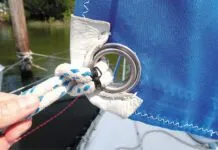Hull/Keel Joint Cracks
My husband and I own a 1978 Columbia 10.7 sailboat. When it came out of the water at the end of last season, we noticed very small cracking in the fiberglass at the point where the hull meets the keel.
Over the past few months, my husband has reviewed back issues of Practical Sailor in search of any suggestions to remedy or minimize the problem. In particular, is there any product available that can be used as a sealer, which also allows some “give” or flexibility that can be used at the juncture of the hull and keel; i.e., silicone, rubber filler, etc.?
Because we’re now looking toward spring and again readying our boat for another season on the Great Lakes, we’re anxious for a practical solution.
Can you help?
Joseph & Anita Fuchs
via e-mail
Cracks at the keel/hull joint are not uncommon as this is an area that is stressed by both sailing and haul-out. Usually, the cracks are just in the paint or filler that covered the joint. But it may crack gelcoat in the area. The glass in the vicinity should be thick enough that there is no structural problem. If you think the cracks are deep and something alarming is going on, then you need to investigate. Hire a surveyor or at least have someone from the yard advise you.
As for the usual problems with the joint, this is an annual rite of spring. Clean the area around the joint. Scrape away paint and old loose filler. Sand and clean with acetone or other solvent. We use a putty knife to smear onto the crack a mixture of epoxy resin and sandable filler, such as WEST System low density fairing compound. This is inflexible and will probably crack again during the next haulout. But it is watertight during the sailing season. Other people like to use a caulk, such as made by BoatLife. You might ask your local store for a recommendation. Don’t use a tough polysulfide like 3M 5200, which will be hard to remove and clean up in the future.
Max-Prop vs. Autoprop
I am considering a 3-blade feathering prop for a 36′ Beneteau (27-hp. engine). Two brands have been recommended-Autoprop and Max-Prop. The principal difference seems to be that the Max-Prop is geared and the blades seem smaller than the Autoprop.
I want the feathering prop to improve power in reverse, reduce drag while sailing and reduce vibration when motoring. Ive also been told that I will reach cruising speed at lower rpm. Is this realistic? I would much appreciate your thoughts as to the relative merits of these two products.
Gary W. Garson
via e-mail
We tested both the Autoprop and Max-Prop at MIT’s hydrodynamic tunnel several years ago. There are pros and cons to each. We’ll try to summarize.
The Max-Prop has flat blades so it is not as efficient in forward as fixed props or the Autoprop. In reverse, however, the flat blades are better than shaped blades that would otherwise (on fixed props) be angled in the wrong direction. That’s why a lot of people like the Max-Prop–for maneuvering in tight marina quarters. They also feather nicely and reduce drag under sail, though the large hub creates more drag than a folding prop. The low efficiency in forward means you have to apply more rpm than you would with a fixed prop with shaped blades. Because most boats are overpowered, this is generally not an issue. It would only cause a problem if you had a small engine for your boat and didn’t have the reserve power necessary.
The Autoprop is ingenious in that it automatically adjusts pitch to the speed desired, so it does require a bit less rpm than a Max-Prop. This was confirmed by a PS reader who had his boat and a friend’s (identical 41-footers) equipped with an Autoprop and Max-Prop respectively. In powering side by side in identical conditions, the boat with the Autoprop turned at a few hundred less rpm.
The reputed downside to the Autoprop is that it requires a bit more rpm before it gets a “bite” on the water, but as soon as it does, digs in voraciously. Under sail, drag with the Autoprop is a bit more than the Max-Prop. Performance in reverse also is supposed to be good.
Prices are comparable and both are of very good quality. It’s not an easy decision.
Rope Care
Have you ever discussed the care of lines? I’m especially wondering about any tips to make lines last longer in hot sunny climates, to keep them soft and pliable, and to keep them from kinking.
Frank Mott
Temple, Texas
There’s not a lot you can do other than soak lines in a bucket of freshwater every once in a while to remove salt.
To reduce wear on lines where they pass through sheaves, etc., sheets and halyards can be switched end for end periodically; this will increase their life expectancy, too.



































